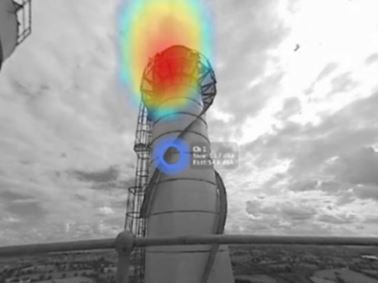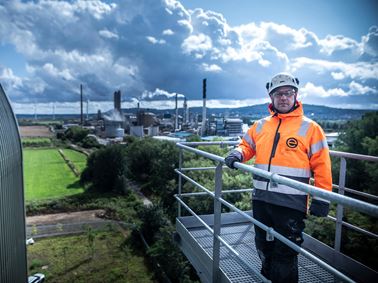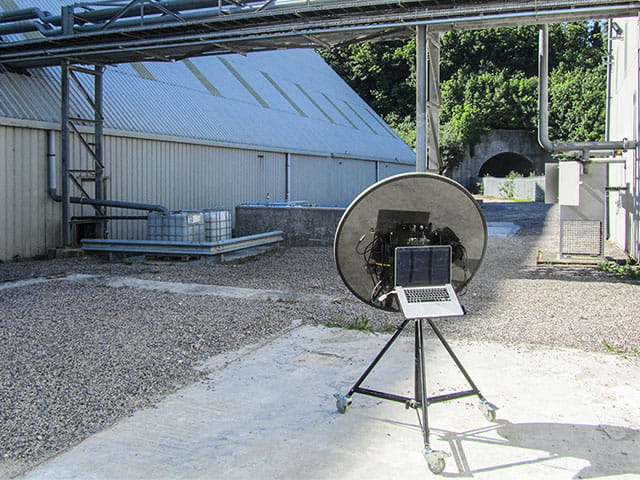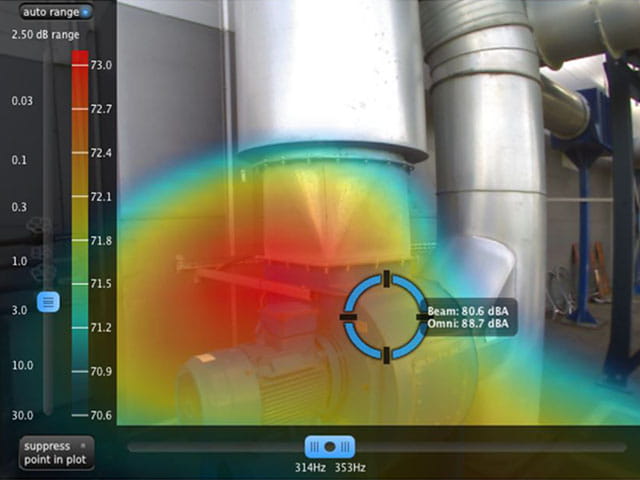Acoustic Cameras For Noise Impact Assessments

By Engaged Expert
Stephen WighamStephen has over 20 years’ experience conducting air quality, noise and vibration assessments for large scale transportation, industrial, commercial, and residential developments.
Acoustic cameras are advanced tools that transform how noise management is approached. These sophisticated cameras can capture both visual and acoustic data, providing a comprehensive analysis of noise sources in a given environment. In this article, Element Expert Stephen Wigham discusses how these cutting-edge tools are revolutionizing noise assessment and empowering decision-making.
What Is an Acoustic Camera?
An Acoustic Camera or “Acoustic Noise Camera” is an advanced device designed to visualize sound sources in a given environment. It captures the level of sound coming from various directions and represents it visually. Unlike traditional microphones that simply measure sound levels, an acoustic camera provides a spatial representation of sound sources, allowing users to pinpoint their locations and assess their intensities.
The typical setup of an acoustic camera involves an array of microphones, often numbering in the hundreds, strategically positioned on a structure or within a dish. For example, the device mentioned in your paragraph employs 256 microphones mounted on a 1.05m dish. This extensive array allows for comprehensive coverage and accurate sound source localization.
Due to the high number of receivers, an acoustic camera can effectively assess low-level noise, making it suitable for various applications where precise noise analysis is crucial. These applications span across industries such as automotive, aerospace, environmental monitoring, and healthcare.
How Do Acoustic Cameras Work?
Acoustic cameras operate based on the principle of analyzing the time delays of sound waves reaching multiple microphones in the array. When a sound originates from a particular direction, it reaches each microphone at slightly different times due to the varying distances involved. By precisely measuring these time delays and comparing them across the microphone array, the system can triangulate the source of the sound.
The process involves sophisticated signal processing algorithms that analyze the delays and reconstruct the sound field in real-time. This reconstructed sound field is then visually represented, often as a map or image, where the intensity and direction of sound sources are depicted.
In simpler terms, imagine each microphone as a pixel in a camera. By analyzing how the sound "hits" each microphone, the system can create a visual "picture" of where the sound is coming from. This visualization allows users to identify and locate sound sources with high precision.
Acoustic cameras find wide-ranging applications across industries. In automotive and aerospace, they aid in noise reduction and quality control efforts. In environmental monitoring, they help identify noise pollution sources. In healthcare, they assist in diagnostic procedures. Overall, acoustic cameras play a crucial role in optimizing products, environments, and processes where sound analysis is paramount.
Why Should Your Industry Consider Using Acoustic Cameras for Noise Impact Assessments?
Acoustic cameras can be used to perform a range of actions for noise assessments, including:
- Source Location and Identification of Tonal Sources for Industry: Acoustic cameras can accurately pinpoint the exact location of noise sources within industrial settings. This capability is particularly useful for identifying tonal sources that may indicate machinery malfunctions or inefficiencies. By identifying these sources, you can take targeted actions to reduce noise emissions, improve efficiency, and comply with noise regulations.
- Sound Insulation: These cameras can be used to assess the effectiveness of sound insulation measures, such as partitions and doors, in buildings. By visualizing sound propagation and identifying weak points in insulation, these cameras help architects, engineers, and construction professionals optimize building designs to minimize noise transmission between spaces. This is crucial for ensuring your occupants' comfort and compliance with noise regulations, especially in residential and commercial settings.
- Wind Turbine Assessments: Acoustic cameras play a vital role in evaluating the noise generated by wind turbines. They enable accurate measurement and visualization of turbine noise emissions, helping you assess the impact on surrounding communities and comply with regulatory requirements. By identifying noise hotspots and understanding the propagation of sound, you can implement mitigation measures to minimize the impact of wind turbine noise on nearby residents.
- Noise Breakout from Buildings: Acoustic noise cameras are effective tools for assessing noise breakout from buildings, particularly in urban environments with high population density. By visualizing sound propagation and identifying areas where noise escapes, you can design and implement effective noise control measures to minimize disturbances to neighboring properties. This is essential for creating livable and sustainable urban environments where residents can enjoy peace.
- Detailed Noise Investigations On Site: Acoustic noise cameras enable detailed noise investigations on-site, allowing you to accurately assess noise sources, levels, and propagation patterns in real time. Whether it's for troubleshooting industrial equipment, evaluating the effectiveness of noise control measures, or conducting environmental noise studies, these cameras provide valuable insights that inform decision-making.
Conclusion
Acoustic cameras are an incredibly useful tool for assessing and managing noise in different domains, including environmental monitoring and industrial settings. By providing precise localization, comprehensive analysis, and actionable insights, these tools enable you to make informed decisions, optimize noise control strategies, and ensure regulatory compliance. This helps in creating a safer and more peaceful environment for everyone.
Whether you're navigating environmental assessments, addressing road and traffic noise concerns, or resolving industrial noise complaints, acoustic cameras serve as indispensable assets in your noise management toolkit. To learn more about how our team at Element can assist you in leveraging acoustic camera technology effectively, please visit our About Us page to discover our credentials and expertise. For more information about our Noise Impact Assessment services or to speak with an expert, don't hesitate to contact us today.
Find related Resources
Case Study: EIA scoping project for Warringtonfire
Learn how we performed an EIA (Environmental Impact Assessment) for the construction of the UK's largest built environment product testing facility.
The project included acoustic design assistance, noise assessments, and air quality dispersion modeling to demonstrate that the new facility would not have a detrimental impact on the local environment. read our case studyFAQ: The latest insights on Noise Impact Assessments
We asked our environmental expert Stephen Wigham to answer Frequently Asked Questions regarding environmental noise assessments and environmental impact assessments.
Discover how our independent environmental compliance experts are helping clients understand the environmental impact of new developments. READ OUR FAQCase Study: Noise Impact Assessment for Eden Geothermal
Read how Element carried out a Noise Impact Assessment on the Eden Geothermal construction project.
During the drilling process, Element provided detailed technical acoustic input into the groundbreaking scheme that is supporting the decarbonization of heat supply for the world-famous Eden Project biomes. read our case studyCase Study: Noise Impact Assessment for National Highways on M32 Eastville Viaduct
Learn how we carried out a noise assessment addressing noise pollution concerns surrounding the M32 Eastville Viaduct in Bristol.
Read our case study authored by Stephen Wigham demonstrating Element’s industry-leading capabilities read our case studyRelated Services

Air Dispersion Modeling
Air Dispersion Modeling computes weather patterns and local topography to predict the concentration of emissions at ground level caused by an emissions source. Find out more.

Stack Emissions Testing
Find out how our stack emissions testing services help our customers to prevent exposure, reduce emissions, improve air quality and achieve regulatory compliance for the industrial installations they operate.

Noise Assessments
Find out how we help our customers to reduce life-changing physical harm such as noise-induced hearing loss or hand-arm vibration syndrome (HAVS) caused by environmental and workplace noise and vibration exposure.

Environmental Impact Assessments
Element’s industry experts provide environmental impact assessments for air quality, noise, and vibration, which must be closely considered through the planning process.

Leak Detection and Repair (LDAR)
We offer comprehensive Leak Detection and Repair (LDAR) services to reduce VOCs and VHAPs (Volatile Hazardous Air Pollutants) emissions and ensure compliance with environmental regulations.

Environmental Compliance & Safety
Element’s industry-leading environmental compliance and safety services help our customers to demonstrate the highest possible standards of environmental compliance and socially responsible performance.

Biogenic Carbon 14 Emissions Monitoring
Find out more about our OFGEM approved Biogenic Carbon 14 Measurement services, used to determine the renewable energy content of waste-derived fuels.

Ambient Air Quality Modeling and Dispersion
Find out how we help our customers comply with regulations for ambient air quality and dispersion modeling.


